Pallet Inverter: What’s the Best Method for Rotating Bulk Component Pallets?
Your team is out on the floor, trying to switch a heavy pallet of bulk components. Maybe they're using two forklifts in a risky maneuver, or worse, they're trying to do it by hand. You see the time ticking away, the potential for someone to get hurt, and the risk of damaging the very products you've worked so hard to produce. This slow, dangerous process is a silent killer of efficiency and a constant drain on your bottom line. It’s a problem that keeps operations managers up at night, wondering if there's a better, safer, and more professional way to handle this essential task.
The best method for rotating bulk component pallets is using a dedicated pallet inverter or pallet changer. This equipment is specifically engineered to securely clamp, rotate, or tilt a full pallet load, allowing for a safe, fast, and damage-free transfer to a new pallet. The ideal type—whether a 180-degree inverter or a 90-degree tipper—depends on the load's stability, weight, and your operational throughput needs.
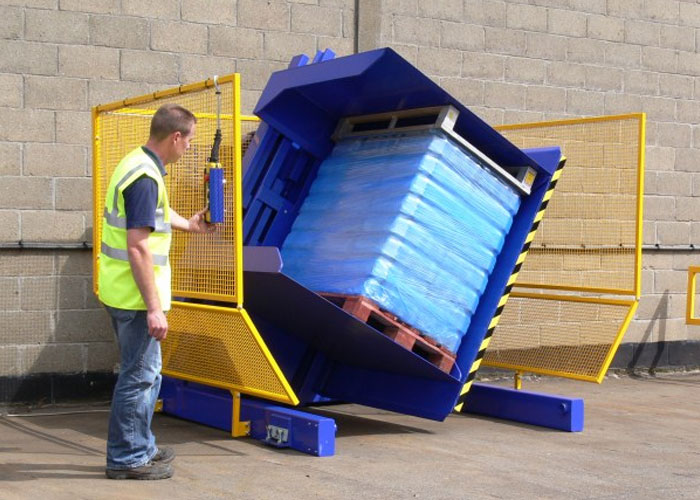
I've spent my entire career on the factory floor, first as an engineer and now as a factory owner. I’ve seen firsthand how small inefficiencies can add up to huge costs. You know you need to solve this pallet rotation problem, but "pallet inverter" can seem like a broad category. Choosing the wrong machine is just as bad as sticking with an inefficient manual process. So, let’s break it down together. We'll look at why the old way is costing you more than you think and how to choose the right machine that will be a true asset for your operation.
You see a team of workers and a forklift driver gathered around a single pallet, getting ready to transfer the load. On the surface, it looks like work is getting done. But as someone who has managed production lines, I see a scene filled with hidden costs and risks. The pressure to keep things moving often forces us to accept these makeshift solutions, but the true cost is staggering when you add it all up.
Manual pallet rotation is a significant hidden cost because it demands excessive labor, dramatically increases the risk of worker injury, leads to frequent product and pallet damage, and creates severe operational inefficiencies that become major production bottlenecks.
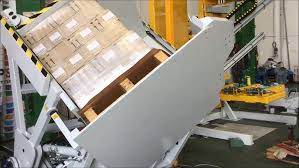
The True Cost of Labor
Let's look beyond the hourly wage. A manual pallet switch often requires at least two people, plus a forklift and its operator. If this process takes them 15 minutes, that’s nearly one collective man-hour spent on a single pallet. Now, multiply that by the number of pallets you switch per day. The numbers add up quickly. But the cost isn't just in wages. It's an opportunity cost. Your skilled team members are tied up in a low-value, repetitive task. They could be contributing to quality control, machine operation, or preparing the next shipment. Instead, they are stuck doing something a machine could do in under 60 seconds. A pallet inverter frees up your most valuable asset—your people—to focus on tasks that grow your business.
The High Price of Accidents
In my years in the industry, I’ve learned that safety is not an expense; it’s an investment. Manual pallet handling is a leading cause of workplace injuries, from back strains to more severe crushing accidents. The "two-forklift" method is particularly dangerous, relying on perfect coordination that can easily fail. One accident can have devastating consequences. You face potential worker compensation claims, government fines, and a loss of morale on the floor. The cost of a single serious injury can easily exceed the cost of the equipment that would have prevented it. A pallet inverter engineers this risk out of your process entirely by creating a controlled, predictable, and safe operation.
Damage and Waste: A Drain on Profits
When a load is handled manually, it's subject to being dropped, tilted too far, or bumped. For bulk components, this can mean cracked parts, torn bags, or dented containers. This damage goes straight to your bottom line as waste. But it doesn't stop there. The pallets themselves are often damaged during clumsy transfers, breaking boards and weakening the structure. A damaged pallet is a safety hazard for the next person who handles it. A pallet inverter provides a smooth, secure transfer that protects both the product and the pallet, preserving quality and reducing unnecessary waste.
| Metric | Manual Method (2 Staff + 1 Forklift) | Pallet Inverter Method (1 Operator) |
|---|---|---|
| Time per Pallet | 10-20 minutes | 1-2 minutes |
| Labor Required | 2-3 people | 1 person (part-time) |
| Safety Risk | High (strains, crush injuries) | Very Low (guarded operation) |
| Product Damage Rate | 2-5% (common) | < 0.1% |
| Process Control | Low / Inconsistent | High / Repeatable |
How do different types of pallet inverters work?
So, you're convinced that a machine is the right path forward. But when you start looking, you see terms like "clamp and rotate" or "load tipper." It can feel confusing, and making the wrong choice means you could end up with a piece of equipment that doesn't fit your product or your workflow. I’ve seen companies buy inverters that were too aggressive for their fragile loads or too slow for their high-volume needs. Let's clarify how these main types work so you can understand which is right for you.
Different pallet inverters use distinct mechanisms to transfer loads. A 180-degree clamp-and-rotate inverter secures the load between two plates and flips it completely upside down. In contrast, a 90-degree tipper or load transfer system leans the load on its side, allowing the pallet to be exchanged before tilting it back upright. The best method depends on your product's stability and your operational needs.
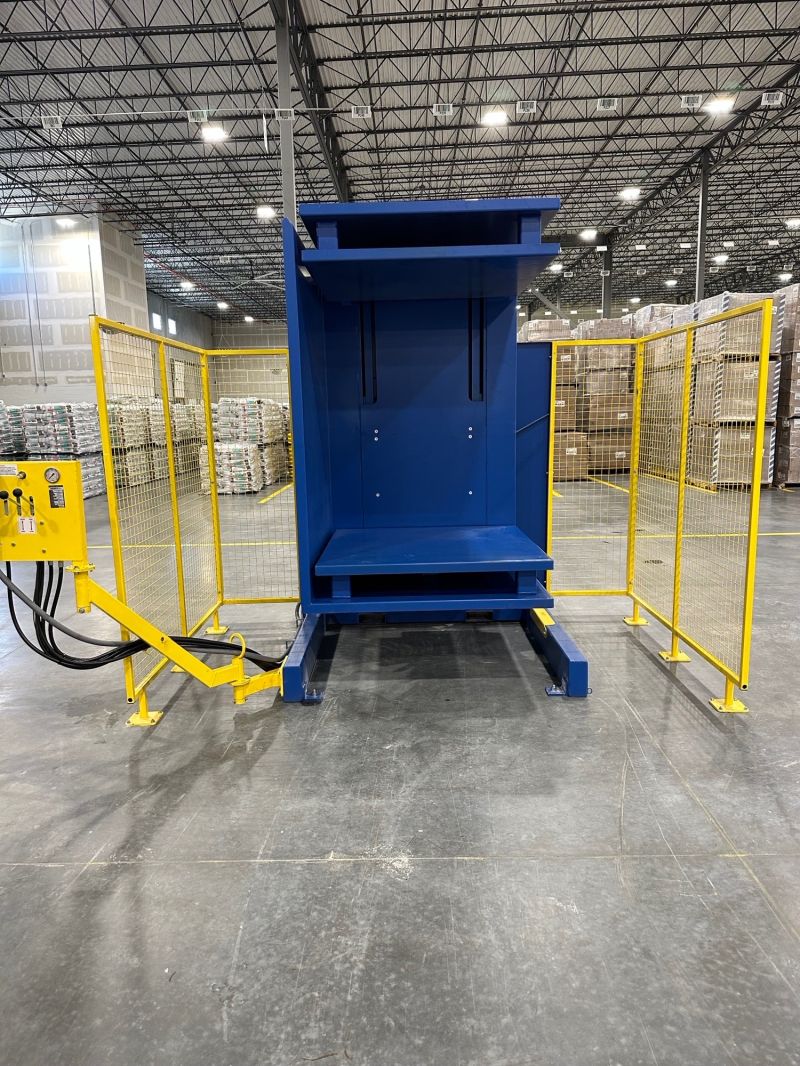
The Workhorse: 180-Degree Clamp and Rotate Inverter
This is often what people picture when they think of a pallet inverter. The process is simple and robust. A forklift places the palletized load onto the machine's base. Two strong, padded clamping plates press together from the top and bottom, securing the entire load. The machine then rotates a full 180 degrees. Now, your original pallet is on top, empty and easy to remove. You place the new pallet on, and the machine rotates 180 degrees back to the starting position. The clamps release, and the forklift can remove the load on its new pallet.
This method is incredibly effective for stable, solid loads like boxes, cartons, or well-stacked rigid components. It is fast, reliable, and straightforward. I remember a client in the steel industry who handled heavy, stacked steel parts. The 180-degree inverter was a perfect fit. It was strong enough to handle the weight and provided a quick, no-fuss transfer that kept their shipping department moving at full speed.
The Gentle Giant: 90-Degree Tipper (Load Transfer System)
Not all loads are perfectly stable. What if you're dealing with bags of powder, open-top drums, or pails of liquid? A full 180-degree inversion could cause a huge mess or damage the product. This is where the 90-degree tipper shines. Instead of flipping the load, this machine gently tilts it back about 90 to 110 degrees, until the load is resting on its side against a solid back wall. In this tilted position, the pallet is free and clear at the bottom. The operator can easily pull it away and slide a new pallet into place. The machine then gently tilts the load forward, setting it down squarely on the new pallet. This method puts minimal stress on the product itself, as it is always supported. It’s the ideal solution for unstable, fragile, or pressure-sensitive goods.
Inline vs. Standalone Systems
Beyond the mechanism, you need to consider how the machine will fit into your factory. A standalone unit is the most common configuration. It can be placed anywhere you have the floor space and is typically loaded and unloaded by a forklift. This offers great flexibility. You can use it for incoming goods in the receiving bay, for outgoing shipments, or for transfers within your production area.
An inline system, on the other hand, is designed for full automation. It is integrated directly into a conveyor line. Pallets move into the machine automatically, are transferred, and then exit onto another conveyor without an operator intervening. This is the ultimate solution for high-throughput operations where speed and efficiency are paramount, directly supporting goals like achieving 95% capacity utilization.
| Inverter Type | Mechanism | Best For (Load Type) | Key Advantage |
|---|---|---|---|
| 180° Clamp & Rotate | Full 180-degree inversion | Stable, robust, boxed, solid loads | Speed and simplicity |
| 90° Tipper | Tilts load 90°-110° to side | Unstable, fragile, bagged, drum loads | Gentle handling, low product stress |
| Inline System | Integrated into conveyor line | High-volume, uniform loads | Full automation, maximum throughput |
| Standalone System | Forklift loaded/unloaded | Varied uses, flexible placement | Flexibility and lower initial cost |
What are the key factors to consider when choosing a pallet inverter?
You've seen the different types, and you're ready to make a change. But this is a significant capital investment. You wouldn't buy a new furnace for a steel mill without a thorough analysis, and the same principle applies here. Choosing a pallet inverter based on price alone or without considering all the variables is a recipe for disappointment. I've seen it happen. The machine breaks down, it can't handle the full range of your products, or it's a safety risk. Let's walk through the critical factors to ensure you get the right tool for the job.
The key factors for choosing the right pallet inverter are, first and foremost, your load characteristics (weight, size, stability), your required throughput (pallets per hour), the physical space and operational flow of your plant, and the necessary safety and automation features that fit your company's goals.
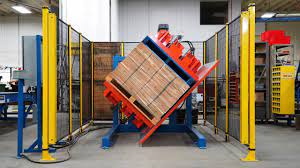
Know Your Load Inside and Out
This is the most important factor, and it cannot be overlooked. Before you even talk to a supplier, you must have this data.
- Weight: What is the absolute maximum weight of a fully loaded pallet you will ever need to handle? Don't guess. Look at your heaviest products and add a safety margin of at least 15-20%. A machine rated for 1500 kg should not be used for a 1600 kg load.
- Dimensions: What are the length, width, and height of your largest and smallest loads? The machine's opening, often called the "jaw opening," must accommodate your tallest pallet load. The clamping plates and base need to be large enough for your pallet footprint.
- Stability: Is your load a solid, stable block, or is it a shifty stack of bags that could slump? This will determine if you need a 180-degree inverter or a 90-degree tipper. For some loads, you might even need a machine with side-support walls to keep everything contained during the transfer.
Throughput and Cycle Time
Be realistic about how many pallets you need to switch. Is this an occasional task, maybe five or ten times a day? Or is this a constant bottleneck where you need to process 40 pallets an hour? A standard, forklift-loaded standalone unit can typically handle 15-20 cycles per hour. If your needs are higher, you must look at a more automated system or an inline machine. Think about your future growth as well. A machine that meets your needs today might be too slow in three years. Investing in slightly more capacity now can save you from having to buy another machine later.
Footprint and Integration
Where is this machine going to live? Walk out onto your factory floor with a tape measure. Some inverters, especially those with loading ramps, require a significant amount of space. Others are more compact and designed specifically for tight spaces. Consider how a forklift will approach it. Is there enough room to maneuver safely? Also, think about your workflow. Does it make more sense to have a central pallet-changing station, or do you need a machine at the end of a specific production line? If you are aiming for greater digitalization, ask if the machine's controls can be integrated with your plant's MES or SCADA system.
Build Quality and Maintenance
As an engineer, this is personal for me. A machine is only as good as its construction. Look for heavy-gauge steel frames, high-quality hydraulic and electrical components from reputable brands, and robust welds. A cheaply built machine will lead to more downtime and maintenance headaches, which is exactly the problem Javier is facing with his aging equipment. Ask the supplier about access for maintenance. Are the hydraulic power pack and electrical panels easy to get to? A machine that is easy to service is a machine that will stay in service.
How can a pallet inverter improve safety and reduce product damage?
Every time you look at your operational reports, you see those two line items: safety incidents and product damage costs. They represent failures in your process. You know that the manual methods your team uses for pallet transfer are the root cause, creating a constant risk that pulls your attention away from your bigger strategic goals. It feels like a fire that you are always putting out. But what if you could eliminate the source of the fire altogether?
A pallet inverter directly improves safety by removing the need for manual lifting and eliminating dangerous forklift maneuvers, as the machine securely contains the load during the entire process. It simultaneously reduces product damage by providing a smooth, controlled, and predictable transfer, which prevents the drops, impacts, and product shifts that are common with manual handling.
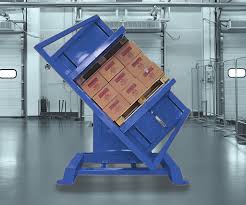
Engineering the Human Risk Out of the Equation
The single biggest safety advantage of a pallet inverter is that it takes the most unpredictable element—human action under physical strain—out of the process. Think about it:
- No More Manual Lifting: Your workers no longer have to bend and lift heavy items to restack a pallet. This eliminates the risk of back injuries, which are among the most common and costly workplace incidents.
- No More Unstable Forklift Tricks: The infamous "two-forklift" transfer or trying to nudge a load with the forks is an accident waiting to happen. A pallet inverter replaces this uncontrolled chaos with a calculated, mechanical process.
- Built-in Safety Features: Modern inverters are designed with safety as a priority. They come with features like light curtains that stop the machine if someone enters the operational area, physical safety caging, and dual-hand controls that ensure the operator's hands are clear of the mechanism during rotation. This creates a protected, predictable work zone.
A Controlled Process Protects Your Products
Product damage is death by a thousand cuts to your profit margin. A pallet inverter protects your products by ensuring a gentle and secure transfer every time. The clamping system applies even pressure, holding the load firmly in place before any movement begins. Whether it's a 180-degree rotation or a 90-degree tilt, the motion is smooth and controlled, not jerky and unpredictable like a manual transfer. This precision minimizes shock and vibration, which is critical for protecting sensitive components, preventing boxes from crushing, and ensuring that neatly stacked items stay that way.
I remember a client who manufactured high-value electronic components. Their manual restacking process was resulting in a 4% damage rate from small drops and impacts. It was a huge source of frustration. After we installed a 90-degree tipper with adjustable clamping pressure, their damage rate fell to virtually zero. The machine paid for itself in less than a year from the saved product alone, not to mention the improved safety and morale on their shipping dock. This is the kind of direct impact on profit margins that every plant owner, like Javier, is looking for.
My Insights: A Pallet Inverter is More Than Steel and Hydraulics
We've covered the technical details: why manual methods fail, the different types of inverters, and what to look for when choosing one. These things are all critically important. You need the right capacity, the right mechanism, and the right safety features.
But after more than two decades in this industry, working my way up from the factory floor to establishing my own company, I've learned a fundamental truth: the machine itself is only half of the solution. The other half, the part that determines long-term success, is the partner you choose to work with. For a forward-thinking leader like Javier, who values strategic relationships, this is the most important consideration of all.
A true partner does more than just sell you a machine from a catalog. They invest time to understand your business. They ask about your specific products, your workflow, your space constraints, and your long-term goals. They want to know about your challenges with energy costs, aging equipment, and market fluctuations. They listen.
Based on that understanding, they help you engineer a "total solution," just as our slogan at SHJLPACK says. This goes beyond the machine. It includes support with installation and commissioning. It includes training your operators and maintenance staff so they are confident and capable. It includes a clear and reliable plan for spare parts and technical support down the road, ensuring your equipment maintains high utilization for years to come.
Most importantly, a strategic partner thinks ahead with you. They'll ask about your plans for digitalization and help you select a machine with the controls to integrate with your MES. They will help you choose a solution that not only solves today’s problem but also positions you for future success.
This industry has given me everything. It allowed me to build a career, achieve financial independence, and help my clients grow their own businesses. That is why I founded SHJLPACK—not just to build machines, but to share what I have learned and to give back. I want to help people build stronger, safer, and more profitable operations. When my clients succeed, we all succeed. That is the only kind of partnership that truly matters.
Conclusion
Choosing the right pallet inverter is more than an equipment purchase; it's a strategic investment in your plant's safety, efficiency, and future profitability. Find a partner, not just a supplier.


